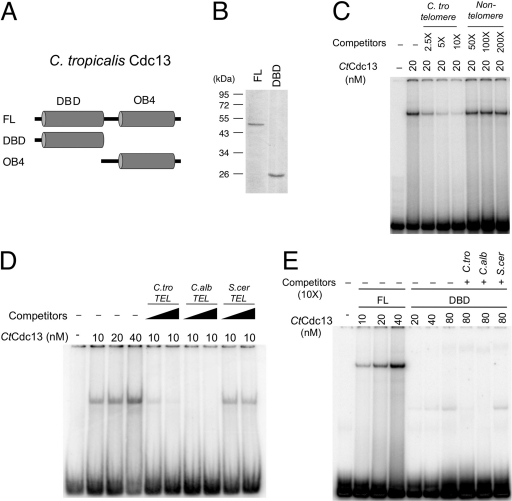Fig 2.
Specific binding of Candida telomeric DNA by C. tropicalis [C.tro] Cdc13. (A) The C. tropicalis Cdc13 protein and the domains tested for DNA binding are illustrated. (B) Purified full-length (FL) CtCdc13 and the DBD were analyzed by SDS-PAGE and Coomassie staining. (C) CtCdc13 was incubated with 7.5 nM labeled C. tropicalis TEL-GX1.5B (see Fig. 3 for sequence), and the indicated competitor oligonucleotides (C. tro telomere, same as the probe; nontelomeric competitor,AATTGTCGACTTATGGAGCAATTCTTGTTAAACA). The resulting DNA-protein complexes were analyzed by native gel electrophoresis. The concentrations of CtCdc13 and the levels of the competitors relative to the probe for the reactions are listed at the top. (D) The indicated concentrations of full-length CtCdc13 were incubated with 7.5 nM probe consisting of two copies of the C. tropicalis telomere repeat (C.tro TEL-GX2). The resulting DNA-protein complexes were analyzed by native gel electrophoresis. The Kd for this DNA-protein interaction was estimated to be ∼40 nM based on the concentration of protein needed to reduce the free probe by 50% (four left lanes). Some assays also included excess unlabeled oligonucleotides consisting of various telomere repeat sequences. These competitor oligonucleotides were added at 2.5-fold or 10-fold molar excess. (E) The indicated concentrations of full-length CtCdc13 or DBD were incubated with 7.5 nM probe consisting of two copies of the C. tropicalis telomere repeat (C. tro TEL-GX2). The indicated competitor oligonucleotides were added at 10-fold molar excess. C.alb, C. albicans; S.cer, S. cerevisiae.

